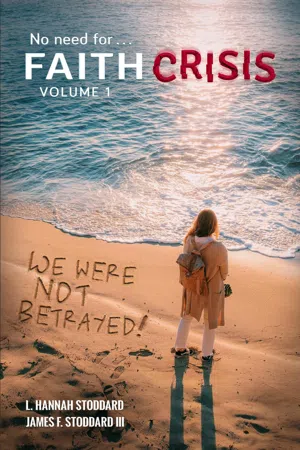
Faith Crisis Vol. 1 - We Were NOT Betrayed!
Answering, "Did the LDS Church Lie?"
- English
- ePUB (mobile friendly)
- Available on iOS & Android
Faith Crisis Vol. 1 - We Were NOT Betrayed!
Answering, "Did the LDS Church Lie?"
About This Book
After working with thousands of struggling members of The Church of Jesus Christ of Latter-day Saints over many years, the authors decided to write a book offeringhopeandanswersfor those struggling with faith crisis.
Unbeknownst to the general Church membership, the 20th century would witness an organized effort to rewrite Latter-day Saint history from within its own ranks.
In a head-to-head, behind-the-scenes-battle, traditional leaders resisted intellectual progressives working in the Church History Department and at BYU, who claimed some forty years ago that it would take a generation to re-educate the Church membership. Where are we in this attempted re-education?
What is the New Mormon History, and how does it personally affect you and your family? Join us as we explore newly-available diaries, review old books, and bring untold history into the light!
- Progressives claim the Churchcovered upits history for nearly 200 years. Is the currentfaith crisisstemming fromunmasked history... ornew interpretations?
- Why did New Mormon Historians insist Hofmann’s forgeries were legitimate, even when investigators provided convincing evidence to them of thehoax?
- How did Bruce R. McConkieknowHofmann’s Joseph Smith III blessing was afake, despite authentication by document experts and pressure by historians calling him “incompetent” for questioning?
- Who were the “Swearing Elders”? How did this group of progressive Latter-day Saintsreshapethe identity of Mormonism?
- Why did Carol Lynn Pearson and Leonard Arrington share cards that read, “History is onour side—as long as we cancontrolthe historians?”
- Leonard Arrington shared that an “invisible higher power” commissioned him to rewrite orreconstructour dominant narrative of the Restoration. DidGodwant our historychanged?
- Why did Leonard Arrington say the First Vision, Nephites and gold plates were part of the Mormon “myth”?
- Why did Leonard Arrington note that if he werehonestabout his beliefs, “not many” Latter-day Saints would “want [him] to teach theirchildren”? How did this affect his career asChurch Historianand later at BYU?
“The research and findings in this volume are truly history altering. Using newly released documents, combined with deep knowledge of Church History, the Stoddards are bringing to light what could be termed a “soft coup d’état” of the Church’s scriptures and prophets by progressive historians, bent on altering its history. Hold tight to your faith in the history held by the church for over 150 years and the teachings of our prophets as you discover how deep this attempted takeover has infiltrated, and altered, our sacred history.” ( Rod Meldrum, researcher, best-selling Latter-day Saint author, & international
Frequently asked questions
Information
Chapter 1: Hofmann & the Forging of the New Mormon History
Table of contents
- Foreword
- Introduction
- Chapter 1: Hofmann & the Forging of the New Mormon History
- Chapter 2: Trusting in Experts or Revelation? Joseph III Blessing & Anthon Transcript
- Chapter 3: Indolent Treasure Digger — The Josiah Stowell Letter
- Chapter 4: Magical Worldview —The Salamander Letter
- Chapter 5: Victims — Murders, Historians & Police Investigation
- Chapter 6: Is Our Dominant Narrative True?
- Chapter 7: The Swearing Elders
- Chapter 8: Divergent Paths — Historians Leonard Arrington & Joseph Fielding Smith
- Chapter 9: Arrington’s Faith Crisis in College
- Chapter 10: Criticism Leads the Camel’s Nose Into the Tent
- Chapter 11: Arrington’s Epiphany
- Chapter 12: Great Basin Kingdom — Materialism? Failure? Autocracy?
- Chapter 13: William Godbe — Spiritualism, Socialism, Economics
- Chapter 14: Waging War Through Education — Battling for the Youth
- Chapter 15: Mormon Historians Move to Take Brigham From His Pedestal
- Chapter 16: Contriving and Mentoring the New Mormon History
- Chapter 17: The Standard of Truth
- Appendix: Eyewitness Accounts of the Prophet Joseph Smith’s Greatness
- Index